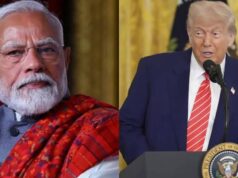Mountaineer’s Final Frontier

By
Colonel Satish Singh Lalotra
‘Great things are done when men and mountains meet’- William Blake.
(18th century English poet)
The above quote typifies a perfect personification of meeting of two different personas, only to generate events which humanity preserves for posterity. For centuries men have romanced with mountains only to be galvanized to undertake tasks considered to be beyond the realm of reality.
Climbing a mountain represents a chance to be briefly free oneself of humdrum of our common lives, strip off nonessentials and come down to the basics of existence. . Food, shelter and friends, these are the essentials plus faith &purpose & a deep unrelenting determination.
In Northern areas of Jammu and Kashmir’s Karakorum, bristling across an area barely 100 miles wide, more than 60 of the world’s tallest mountains lord over these severe alpine beauty over a witness less high altitude wilderness.
Except for the occasional snow leopard and Ibex, so few living creatures have passed through this area that discovery of world famous Mt K2, Broad peak, Gasherbrum 1 and Gasherbrum 2 was little more than a rumor to the world at large.
A typical complex mass of peaks obtaining in general area Hispar/Biafo/Baltoro glacier, now part of Northern areas of Pakistan creates the world’s longest glacial system outside of the polar regions.
These peaks form Part of 3 glaciers which together having a length of 100 kms/62 miles connect 2 ancient mountain kingdoms of erstwhile princely state of J&K, Nagar ( immediately south of Hunza) in the west with Baltistan in the east.
The international mountaineering and climbing federation or UIAA recognizes 8 Thousanders as those 14 peaks that are more than 8000 meters or 26, 247 Ft high above the mean sea level and are sufficiently independent from neighbouring peaks.
Out of these 14 tallest 8 thousanders, 4 are located in the Karakorum ranges in Northern areas of Pakistan, 3 in Nepal, and the remaining 7 situated on the Nepal -Tibet border. The summits of all these 14 peaks are in the Death Zone.
In the mountaineering parlance Death Zone refers to altitudes which are above a certain point where the amount of oxygen is insufficient to sustain human life for an extended period of time.
This point is generally tagged as 8000 meters. The term being in vogue since 1953 and coined by a Swiss doctor Edouard Duantana. This glacial area comprising Hispar/Biafo/Baltoro used to be part of Gilgit /Baltistan of J&K before 1947 and was usurped by Pakistan using coercive methods immediately after independence.
My interest in this area was fuelled primarily by my stint in the Siachen glacier while in service in the mid 90s. An area close to the Eight thousanders which further got a fillip while viewing a movie Vertical limit, a Hollywood thriller directed by Martin campbell, starring Chris o Donnell and Bill Paxton etc.
The film features a failed attempt on Mt K2 and a heroic rescue undertaken by the expedition members in cohort with the PAF ( Pakistan air force). My latest reason for evincing interest in this region was again a famous book Three cups of tea by Greg Mortensen, an accomplished American mountaineer cum philanthropist.
Based again on a failed attempt on Mt K2 by Greg who was propelled by a poignant personal tragedy, the failure resulted surprisingly in serendipity, when Greg found his calling in life and founded a maiden project CAI (Central Asian institute).
Such was the intensity and sincerity of cause behind establishing CAI, that a person no less than former US President Barrack Obama donated 50% of his Nobel peace prize to fund it and take it to its fruition.
Not to be left behind, the then Pakistan President General Parvez Musharaf made available his personal helipad and a Vietnam era Alouette helicopter along with Brigadier Bhangoo one of the top most experienced high altitude helicopter pilot of PAF on standby to ferry Greg across the inhospitable terrain of Northern areas to scout school sites.
Karakorum mountains derive their name from the 13th century capital of Mongol warrior king Ghengis khan and his successor son Ogodei Khan located in central Mongolia. Karakorum forms the natural border between Pakistan/china/india.
The 14 Eight (8) Thousander peaks in the world is a number that pushes climbers to the point of obsession, its big enough that only the most ambitious consider it climbing all of them, but small enough that doing so over a life time still seems possible.
Reinhold Messner the first climber in the world for having scaled all 14 Eight thousanders explains the allure behind climbing-Its not the peak, but the view from the top of the peak that suggests increased awareness.
Of all the 14 Eight thousanders in the world, the ones which are located in the Northern areas of Pakistan i. e Mt K2, Broad peak, Gasherbrum-1/K5, Gasherbrum 2/K4 are the killer or savage mountains owing to their remoteness.
But again here the cake goes to Mt K2 the 2nd highest mountain in the world in so far as for its savageness and sheer topographical complexity. Located astride Godwin Austin glacier, it is said that the sides of Mt K2 are so steep and pyramid in shape that fresh snow hardly rests on its shoulders.
Also known as Mt Godwin Austin or Chhogri(Balti language-king of mountains) the name K2 was first used by Great Trigonometrical survey of British India. Thomas Montogomerie made the first survey of the Karakorum range way back in 1856. But imagine the beauty of this whole survey — It was done 210 kms away from another prominent peak in the Kashmir valley, the Mt Haramukh in the south. Such dexterity that even today all survey computations in that region are based on those findings.
The Great Trignometrical survey of British india decided to use the local names for the mountains so identified, and hence the name K-1 (K -standing for Karakorum and 1 for the 1st peak so identified) for example Masherbrum ( local Balti language) means Masher (beautiful) and Brum means mountain.
The savagery of Mt K2 can be gauged by the fact that till date only 300 climbers have been able to scale it, with over 80 having perished in attempting to do it since the early 20th century, with none having scaled the monster in winters up till now. As opposed to this, Everest, where appx 2700 climbers have had the opportunity to step on the highest point of earth is comparatively tame.
A first timer arriving at the base camp of Mt K2 has a sobering effect on viewing the Gilkey memorial erected in the memory of all those climbers who came from all over the world to scale it, only to meet an icy and forlorn death in the depths of unending crevasses and avalanches.
The Gilkey memorial is a grisly necessity because corpses rarely make it down the mountain in one piece. For Everest losses, families sometimes send a recovery team, which doesn’t happen with K2 the killer mountain. This savage mountain devours all its victims during the long winters between the climbing sessions.
It encases the torso in ice and decades later scattering limbs, entrails among the avalanche debris. For more than 50 years the Gilkey memorial has been at place at Mt K2 to caution the living and consecrate the dead mountaineers attempting the summit, reminding themselves of what they are getting into. On hot days at the memorial, the cairn stews with the scent of defrosting flesh.
The last inhabited Pakistani/ Balti village near these peaks is Askole, which incidentally has turned into an international cacophony with intermingling of various nationalities of climbers making their way forward to the base camp. It also is the last and first point of human contact with the outside world for the climbers on their way to and return from their expeditions to the 8 thousanders.
The best climbing season for these 8 thousanders is from June to September which requires lot of climbing permission, permits, arranging of Liaison officers and deposit of climbing fees to the Pakistani govt.
A few miles away from Askole is village Korphe which mistakenly Greg Mortensen reached after having drifted along river Braldu in a semi conscious state during his failed American expedition in 1993 to Mt K2, only to be rescued in the nic of time by his Balti porter Mouzafer Ali to safety.
The vital statistics of these four 8 thousanders starting with Mt K2 are-
Its generally said and believed that men and mountains have a symbiotic relationship between them, each constantly goading the other to cross the Rubicon to prove their supremacy over other.
The latest race between man and mountain is that of Denis Urubko who was forced back at 7660 mts on 03 Feb 2020 by heavily crevassed terrain at Broad peak and resumed his trek again on06th Feb 2020 after getting a breakthrough in the weather. During one such crossing of Rubicon by Greg Mortinsen, proved to be a blessing in disguise for the suffering humanity of Northern Pakistan.
In his effort they found a messiah who would change the world of their school going children for ever and deliver them from their unending woes. The world famous book, Three cups of Tea co-authored by him and Oliver Relin first published in 2006 is again a poignant reminder of the constant tussle for supremacy between man and the mountain, often throwing fruits of serendipity in the form of opening of 55 schools in general area Korphe, Askole, Skardu, Swat etc by CAI (Central Asian institute) single handedly against threats from AlQuaida.
The same zest for reaching out to the Balti people and locals as such in SWAT valley led Malala Yousafzai the famous Nobel prize winner to put her life on the firing line going against the diktats of the militants operating there.
This act of supreme sacrifice by Greg was undertaken as a small gesture of repayment of gratitude towards the people of Korphe for saving his life in 1993 on a failed mission toMt K2.
Scalded by his failed experience at Mt K2, and submerged in an ocean of love shown by one of the most deprived communities of the world, Greg sold all his property at US, met the high and mighty in Washington only to raise CAI an entity which was solely his brainchild.
With monetary help extended by the then US president Barrack Obama out of his Nobel peace prize money, Greg and his tireless team undertook tasks which should have been the sole preserve of the Pakistan govt as its sovereign duty in the northern areas. Never the less for common people of northern areas of Gilgit /Baltistan CAI is no less than God incarnation.
In addition to the above, mountaineers in particular from all over the world who come to testify their sojourn with the various 8 thousanders in Gilgit /Baltistan act as ambassadors of their countries ferrying the goodwill to and fro from their climbing site.




